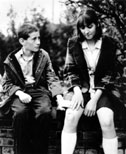
Movie Guru Rating:

Comment
on this review
| |

In Ratcatcher, life is short, dirty and cheap
by Jesse Fox Mayshark
At the beginning of Ratcatcher, the visually and emotionally arresting debut feature from Scottish director Lynne Ramsay, two boys are playing next to a murky, polluted canal. They fling mud at each other. Then they throw each other in the water. Then they start fighting. Finally, one of them stalks off, angry. When he turns around to look back, he sees the other boy has not resurfaced. There are bubbles on the water, then nothing.
The rest of the movie is about that boy, the one looking back, a 12-year-old named James. Ratcatcher springs from the same slum-children genre as Los Olivados, Salaam Bombay! and The Bicycle Thief. But Ramsay is no social realist. As tough and grimy as her depiction of Glasgow in the early 1970s gets, it never feels like reportage. It's a subjective film, seen from the inside of James' muddled and weirdly affectless view of the world.
Using a largely non-professional cast (who speak in barely comprehensible Scottish accents—the movie's subtitles are a little annoying, but they're often necessary), Ramsay tries to grasp the psychological impact of living in the margins of a society that doesn't really have much use for you. James' family life isn't as grim as some cinematic depictions of poverty. His parents are still married, and his father is a drunk but he's a drunk with a job. They live in deteriorating public housing blocks, but they're waiting for permission to move to new, nicer quarters.
Still, there is a core hopelessness to their lives. There's no sense of a possibility of advancement beyond whatever gets doled out by capricious government officials. If the children go to school (and we never see any evidence that they do), it clearly doesn't have much effect on them.
Ramsay, who grew up in Glasgow, set the film during a 1973 garbage collectors' strike that she remembers from her childhood. In James' neighborhood, where families are packed in by the dozens, that means the refuse piles up in giant stinking heaps, attracting disease and herds of rodents. Local policemen rally the residents to track down and kill as many rats as possible, an activity the local children take to gleefully.
James (played with a persuasive vulnerability by William Eadie) isn't much concerned with any of that. He doesn't seem much concerned with anything, really. He wanders around, falling in with a gang of older, rougher boys and initiating an oddly innocent romance with a girl the other kids alternately use and deride. But from the worried and puzzled looks on James' face, we know he is still sorting out his feelings about the boy who drowned at the beginning.
Shortly after that first act of accidental violence, James and his younger sister catch a mouse in the family apartment. They play with it for a few minutes until their father sees them and summarily drops the mouse in the toilet and flushes. The symmetry between the two drownings—boy and mouse, mouse and boy—is repeated several times. Like the mice and rats that thrive in the garbage, James and his family are seen by the authorities that govern their lives as, at best, problems to be solved and, at worst, a scourge.
It's an easy equation, maybe too easy. Ramsay's approach would risk either condescension or over-simplification if her characters weren't so deeply drawn. Besides James, there is the girl, Margaret Anne (Leanne Mullen), whose first awkward overture is to invite James to touch an ugly, gaping cut on her knee. And there's James' friend Kenny, a disturbed boy who catches wild animals in the hopes of someday starting a zoo. Their dreams, such as they are, are hollow fantasies, pantomimes of lives they see on TV. Their daily reality hems them in like creatures in cages.
The movie's best scene, its heartbreaking thesis in one gorgeous swoop, comes during James' sole successful escape. With no destination in mind, he boards a city bus and rides to the end of the line. There in the Glasgow suburbs, he finds a new housing complex under construction. He walks through it, dallies in an empty, gleaming bathtub, and then walks into a darkened bedroom that looks out on an endless field of golden grain. Enraptured, he leaps through the window and runs through the grass, spinning and rolling, the camera soaring above and alongside him. It's a beautiful moment and a perfect piece of filmmaking.
It is also unrepeatable. When James returns to the complex later, it's raining and the houses are almost finished, with locked doors and windows that shut him out. From that point on, the film's ending seems inevitable. What James comes to realize, with both horror and resignation, is that his own life is as expendable as that of the boy who drowned, or the mouse, or the rats his friends kill.
Ramsay came to Ratcatcher bearing the burden of expectations. Her short film Gasman won honors at Cannes a few years ago, and she's being touted as the new great hope of U.K. cinema. There are moments in Ratcatcher when she seems to be trying too hard, using film-school camera tricks when simplicity would suffice. But she's largely successful at marrying a personal, sometimes surreal style to her uncompromising script. Her ability to imagine lives sucked dry of hope represents a triumph of art—even as it condemns her characters to their own brutal awareness of the world.

March 29, 2001 * Vol. 11, No. 13
© 2000 Metro Pulse
|